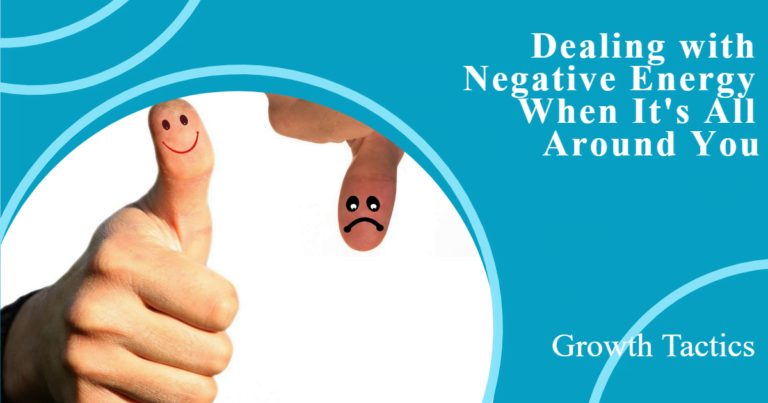Negative energy can seem like it’s all around us sometimes. Whether it’s a grumpy coworker, constant complaining from a friend, or scrolling through angry social media posts, that negativity can bring us down.
I remember a time when I was stuck in traffic on my commute home from work, already exhausted from a busy day. The car next to me was blasting loud music with explicit lyrics, while the driver behind me was honking and making obscene gestures because I wasn’t accelerating fast enough from the red light. I could feel my shoulders tensing and my mood worsening. It felt like a wave of toxic energy washing over me, triggering feelings of anger and anxiety.
In our daily lives, we all encounter challenging people and situations that can zap our energy and make us feel bad. While we can’t always control external circumstances, we can control how we respond internally. This allows us to take back our personal power and prevent negative energy from dragging down our mood, mindset, and well-being.
With mindful awareness and intentional techniques, we can learn to protect our energy, offset negativity with positivity, and feel resilient in the face of draining forces. In this article, we’ll explore proven strategies for dealing with negative energy, so you can maintain a higher vibration even when surrounded by negative vibes.
Jump To Section
What is Negative Energy?

Negative energy refers to emotions, thoughts, or vibrations that make you feel bad or drained. It often stems from negative thinking patterns, toxic people, or difficult situations. There are a few main types and sources of negative energy:
- Toxic energy from other people. This can come from those who frequently complain, judge, criticize, or have a victim mentality. Their pessimism and drama can rub off on you.
- Negative thoughts and emotions within yourself. Feeling excessive anxiety, anger, resentment, jealousy or other toxic emotions can pollute your own energy. Obsessive negative thinking drags down your vibe.
- Stressful situations. Going through hardships like grief, financial troubles, illness, or relationship conflicts can understandably lead to negative emotions and energy.
- Low vibration environments. Certain places with a lot of chaos, anger, or despair tend to hold heavy, gloomy energy. Think of a crowded subway at rush hour versus a peaceful nature trail.
Negative energy often feels heavy and draining. It can manifest as exhaustion, moodiness, tension, or feeling emotionally drained around certain people or places. Learning to protect your own energy is crucial for wellbeing.
How Negative Energy Affects You
Negative energy can profoundly impact your mood, emotions, and mental state. When you’re surrounded by negativity, it’s easy to start feeling down, anxious, or depressed. The pessimism and toxicity seem to seep into your mindset.
Negative energy also has the effect of draining your energy levels. You may start to feel tired, lethargic, and lack motivation. This is because negative emotions like fear, anger, and sadness have lower vibrational frequencies. When someone exudes these emotions, it brings down the vibe of the whole room.
As a human being, you have your own energetic frequency. If you’re around lower vibes for too long, it can lower your own vibration. You may stop feeling inspired, happy, or peaceful. Your aura or energy field absorbs the negativity around you. This is why it’s so important to cleanse your aura and find ways to raise your vibration, through meditation, affirmations, visualization, and surrounding yourself with positivity.
Setting Boundaries
Setting healthy boundaries is crucial for limiting your exposure to negative energy. When we allow ourselves to be treated poorly or overextend ourselves for others, we deplete our own energy reserves.
It’s perfectly valid to limit interactions with people or situations that leave you feeling drained. You have every right to say “no” to requests that exhaust you, even if they come from family or friends. Listen to your intuition – if someone or something doesn’t feel right, don’t force yourself to endure it.
Try to identify where your energetic boundaries end and others begin. What makes you feel good versus what triggers stress or anxiety? Negative emotions are a clue you may need firmer boundaries. For instance, consistently feeling irritated or resentful around a certain person indicates their behavior may be draining.
Don’t be afraid to speak up when you’ve reached your limit. Politely but firmly tell others when their actions are unhelpful. “I’m starting to feel anxious from all this complaining about work. Could we please change the subject?” You can also silently visualize a protective barrier around yourself. Imagine negative energy bouncing off your personal force field.
Setting boundaries allows you to control the type of energy you’re exposed to. Prioritize your emotional and mental well-being over pleasing or placating others.
Avoid Complaining

Complaining spreads negativity and reinforces negative thought patterns. When you complain, you’re focusing on and giving energy to the negative aspects of a situation. This fuels more negative emotions and thoughts.
Complaining also drags down the people around you. Hearing constant complaints is draining and makes others feel bad too. It brings down the whole environment.
Instead of complaining:
- Notice when you start to complain and catch yourself.
- Reframe the situation to focus on positive aspects or solutions. Ask yourself, “How can I improve this?” or “What can I learn here?”
- Express your feelings in a constructive way. Say how you feel and what you need, without blaming others.
- Direct conversations to more positive topics that uplift you and others.
- Be part of the solution. Take positive action to improve situations, rather than just criticizing.
Shifting your mindset to look for the good rather than vocalizing the bad can make a huge difference. It not only stops the spread of negativity but lifts up the people around you.
Practice Gratitude
Feeling grateful can be a powerful way to invite more positivity into your life and shift away from negative energy. Here are some tips for practicing gratitude:
Appreciate what you have – Take time each day to reflect on the people, experiences, and things you’re grateful for. It could be your health, loved ones, a favorite hobby – anything that brings meaning or joy. Savor the good in your life.
Notice positive aspects daily – Train your mind to spot the silver linings and bright spots, even on difficult days. Focus on what’s going right and be thankful for small pleasures.
Keep a gratitude journal – Writing down a few things you’re grateful for every day reinforces the habit of appreciation. It creates a record of positive experiences to look back on when you need a boost.
Visualization Techniques
Visualization is a powerful tool for overcoming negative energy. By envisioning positivity, you can cleanse negative energy from your mind and spirit. Some visualization techniques include:
Guided Imagery for Positivity
Sit comfortably and close your eyes. Take a few deep breaths to relax. Picture yourself surrounded by a soothing white or golden light – this represents positivity and inner peace. Imagine the light fills your body, heart, and mind, cleansing away negative energy. Visualize negative thoughts, emotions, and energy dissolving. Focus on the positive sensations.
Envision Negative Energy Being Cleansed
Visualize any negative energy around you as a dark cloud. In your mind, see the dark cloud being surrounded by pure white light. Watch as the light dissolves the dark cloud, cleansing away the negative energy completely. Imagine your space filled with bright, positive energy. Envision your mind and body purified and re-energized.
Regularly practicing these visualizations can help cleanse negative energy, boost positivity, and maintain a higher vibration. Visualization helps you take control of your inner state and energetic environment. With consistent practice, it becomes easier to let go of negativity and embrace positivity through the power of your imagination.
Affirmations
Affirmations are positive statements you repeat to yourself to reinforce empowering beliefs. When dealing with negative energy, affirmations can be a powerful tool to boost your mood and counteract negativity. Here are some examples of affirmations for positivity:
- I radiate joy, love, and light.
- I am filled with optimism and hope.
- My life is blessed.
- I am grateful for all that I have.
- I have the power to create positive change.
- My thoughts create my reality.
- I choose to see the good in every situation.
To make your affirmations more effective, follow these tips:
- Make them positive. Affirmations work best when they are stated in the positive (e.g. “I am happy” rather than “I am not sad”).
- Personalize them. Use “I” statements focused on yourself to make them more impactful.
- Keep them short and simple. Long affirmations can be hard to remember. Aim for 5-10 words.
- Repeat them regularly. Consistency is key. Repeat your affirmations first thing in the morning and throughout the day.
- Say them aloud or write them down. This reinforces them and makes them feel more powerful.
- Visualize them. Picture yourself already embodying the affirmation to strengthen its effect.
- Feel the emotions. Connect with the feelings of happiness, confidence and empowerment your affirmations evoke.
- Believe in their message. Have faith in the transformative power of your affirmations. What you believe is what you will achieve.
Affirmations require commitment and practice to truly change your thought patterns and energy. But with consistency, they can be very effective for maintaining positivity when faced with negativity around you.
Meditation

Meditation is a powerful way to clear and calm the mind, especially when you’re surrounded by negative energy. When you meditate, you learn to observe your thoughts without reacting or judging. This helps you respond more calmly when faced with negativity, rather than instantly reacting.
Meditation also naturally raises your vibration. As you quiet your mind and focus inward, you tap into a higher state of consciousness that vibrates at a frequency of peace and stillness. This can offset any lower vibrational energies around you.
Try setting aside 10-15 minutes daily to practice meditation. Find a quiet space, sit comfortably, close your eyes, and bring your awareness to your breath. If your mind wanders, gently return your focus to your breath. When you’re centered in the present moment, you’ll feel a sense of calm that negative energies can’t penetrate.
Conclusion
In summary, negative energy can have a real impact on our well-being. It’s important to limit our exposure to negativity by setting boundaries, avoiding complaining, and surrounding ourselves with positivity.
When we encounter negative energy, there are techniques we can use to protect our own energy. Practicing gratitude, meditation, visualization, and using affirmations can help us stay centered.
While we can’t always control external negativity, we have power over our internal state. By cultivating self-awareness and our own positive mindset, we can limit the influence of negative forces. With practice, we can become adept at maintaining an uplifted state of mind, regardless of what negativity surrounds us. Our inner light can withstand even the most challenging darkness when we tend it with care.


